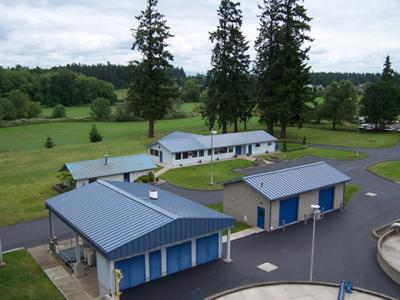Canby Wastewater Treatment Plant
The City’s wastewater treatment plant protects public health by operating 24 hours a day, 7 days each week, treating more than 375 million gallons of wastewater per year. The facility was originally constructed in 1948 and has been upgraded over the years to meet more stringent regulatory requirements.
Throughout the City of Canby, over twenty-one miles of sewer lines convey wastewater from homes and businesses to the plant where advanced technologies treat over a million gallons per day. The treated water is returned to the Willamette River, meeting water quality standards established by the Environmental Protection Agency (EPA) and the Oregon Department of Environmental Quality (DEQ).
Wastewater Treatment and How it Works:
Preliminary Treatment: Wastewater enters the treatment plant through the headworks where grit and screenings are separated, collected and transported to the landfill. These materials can clog pipes and damage equipment if not removed effectively.
Primary Treatment: Primary clarifiers aim to slow down the velocity of flow and separate solids. Dense solids readily settle in primary clarifiers while floating solids, fats, oil and grease are collected from the surface. The collected solids are pumped to a storage tank for additional processing. The cleaned water continues on to the secondary treatment process.
Secondary Treatment: Aeration basins are the home of naturally occurring microorganisms that can be found in rivers, streams and healthy soils. This is where we intentionally mix air, sewage and bacteria to break down organic matter. This process grows bacteria, releases carbon dioxide and ammonia. Specific anoxic and aerobic zones are created to reduce the biochemical oxygen demand and through nitrification, reduce the ammonia as well. This is a delicate process that requires continuous monitoring, sampling and analysis to reach peak performance.
After the microorganisms metabolize the food, they settle out with the help of gravity. Based on the organic food supply, some of the microorganisms are recycled back to the aeration basins and the remainder are pumped to solids processing.
Tertiary Treatment: Alum can be added to help fine particles stick together and prepare for removal through the tertiary filters. This step of the process is much like the process utilized to produce drinking water and yields effective results.
Disinfection: Ultraviolet (UV) disinfection is used to inactivate bacteria so that the bacteria can’t reproduce. UV has the ability to disinfect in seconds and is chemical free. After disinfection is complete, the cleaned water is returned to the Willamette River.
Solids Handling: Solids are stored, aerated and processed over a belt filter press. The dewatered solids are transported to a lagoon for additional treatment to meet Class B biosolids requirements.
To Schedule a Tour
- Public or private schools
- Private group or individual
Contact: 503-266-1248
